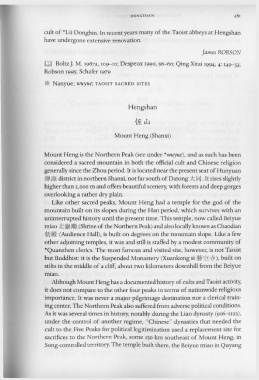Page 521 - The Encyclopedia of Taoism v1_A-L
P. 521
HENGSHAN
cult of *Ui Dongbin. In recent years many of the Taoist abbeys at Hengshan
have undergone extensive renovation.
James ROBSON
III BoltzJ. M. 1987a, 109- 10; Despeux 1990, 56-60; Qing Xitai 1994, 4: 149- 53;
Robson 1995; Schafer 1979
* Nanyue; wuyue; TAOIST SACRED SITES
Hengshan
Mount Heng (Shanxi)
Mount Heng is the Northern Peak (see under *wuyue), and as such has been
considered a sacred mountain in both the official cult and Chinese religion
generally since the Zhou period. It is located near the present seat of Hunyuan
$ ilW- district in northern Shanxi, not far south of Datong 7c I8J . It rises slightly
higher than 2,000 m and offers beautiful scenery, with forests and deep gorges
overlooking a rather dry plain.
Like other sacred peaks, Mount Heng had a temple for the god of the
mountain built on its slopes during the Han period, which survives with an
uninterrupted history until the present time. This temple, now called Beiyue
miao ~tf,jk!@ (Shrine of the Northern Peak) and also locally known as Chaodian
ijiA ~ (Audience Hall), is built on degrees on the mountain slope. Like a few
other adjoining temples, it was and still is staffed by a modest community of
*Quanzhen clerics. The most famous and visited site, however, is not Taoist
but Buddhist: it is the Suspended Monastery (Xuankong si ~:£~), built on
stilts in the middle of a cliff, about two kilometers downhill from the Beiyue
miao.
Although Mount Heng has a documented history of cults and Taoist activity,
it does not compare to the other four peaks in terms of nationwide religiOUS
importance. It was never a major pilgrimage destination nor a clerical train-
ing center. The Northern Peak also suffered from adverse political conditions.
As it was several times in history, notably during the Liao dynasty (916-II25),
under the control of another regime, "Chinese" dynasties that needed the
cult to the Five Peaks for political legitimization used a replacement site for
sacrifices to the Northern Peak, some ISO km southeast of Mount Heng, in
Song-controlled territory. The temple built there, the Beiyue miao in Quyang

